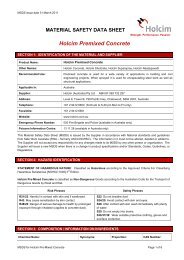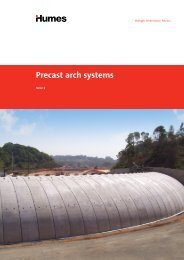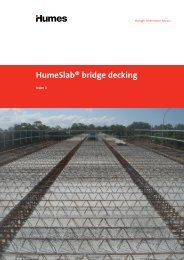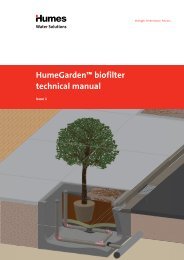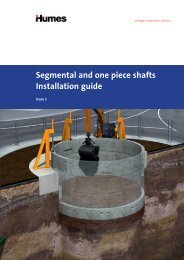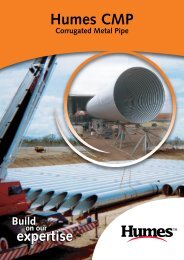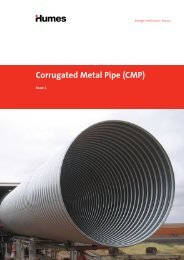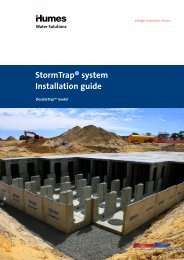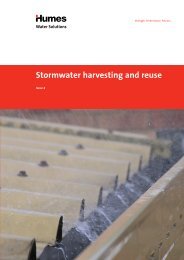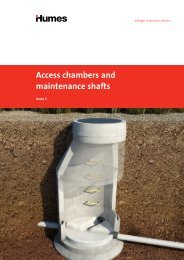Plastiline™ - Humes
Plastiline™ - Humes
Plastiline™ - Humes
You also want an ePaper? Increase the reach of your titles
YUMPU automatically turns print PDFs into web optimized ePapers that Google loves.
SUMMARY OF PRINCIPAL<br />
PROPERTIES<br />
1 Tensile strength<br />
Longitudinal and transverse tensile test results exceed<br />
17 MPa. This strength combined with excellent<br />
mechanical interlock of keys in concrete means permanent<br />
fixture. Weep channels prevent build-up of back pressure<br />
caused by any moisture behind the sheet, except in the<br />
case of fully-lined structures, where special precautions are<br />
required.<br />
2 Elongation<br />
Not less than 225% at failure and together with the<br />
tensile strength allows coverage of flexible joints without<br />
damage to the lining.<br />
3 Porosity<br />
Gases and solutions will not penetrate Plastiline.<br />
The sheet is an homogeneous extrusion, free from<br />
pinholes. Spark testing at at least 10,000 volts after<br />
manufacture checks the entire surface of all sheets.<br />
4 Plasticiser permanence<br />
Use of a stable plasticiser ensures high plasticiser<br />
permanence. Samples recovered from live sewers after up<br />
to 30 years in service validate this performance property.<br />
Also the laboratory testing determined loss of plasticiser<br />
under vastly accelerated test conditions at 90 O C does not<br />
exceed 1%.<br />
5 Weldability<br />
Jointing and sealing together sections of Plastiline is<br />
readily achieved by a trained operator using a heat fusing<br />
process. The resultant weld is equivalent in protection to<br />
that of the parent sheet.<br />
6 Temperature effects<br />
Flexibility of the sheet increases with rising temperatures<br />
but otherwise this material is not affected by the normal<br />
range of ambient temperatures. In most cases Plastiline<br />
is suitable for pipeline temperatures normally encountered<br />
and up to 80 O C for limited periods not exceeding 24 hours.<br />
Normal steam curing of concrete does not affect<br />
Plastiline except for temporary softening of the sheet.<br />
7 Embedment<br />
Keys are designed for easy embedment during the pipe<br />
lining process and to give positive mechanical lock into the<br />
pipe or structure. Keys will withstand a test pull<br />
normal to the concrete, equivalent to a minimum of<br />
14 N/mm length of key, refer Clause 11.4 page 17.<br />
8 Water absorption<br />
At a temperature of 23 O C the maximum water absorption<br />
is 0.10% after 24 hours. This low percentage illustrates the<br />
fact that water penetration is negligible and the sheet forms<br />
an impermeable barrier.<br />
10 Tear strength<br />
The value of 80 N/mm minimum tear strength, both<br />
longitudinally and transversely, reflects the toughness<br />
of the material. Although a sharp instrument may<br />
puncture it, there is no tendency for the perforation to<br />
progress further.<br />
11 Abrasion resistance<br />
Plastiline possesses higher abrasive resistance qualities<br />
than concrete itself. Recommended velocity limits in<br />
sewers are 6 m/s in straight sections and 3 m/s at curves.<br />
12 Food contact<br />
Standard Plastiline should not be used to line food<br />
containers.<br />
13 Combustion<br />
Plastiline will not support combustion.<br />
RESISTANCE TO<br />
AGGRESSIVE AGENTS<br />
The ability of PVC to resist deterioration when exposed<br />
to a wide range of chemical substances is well known.<br />
Some of the more common substances which can collect in<br />
sewers as effluent from industrial processes are listed<br />
below. For information on the resistance of PVC to other<br />
substances, enquiries may be made to <strong>Humes</strong>.<br />
1 Acids<br />
Completely unaffected by almost all dilute mineral and<br />
organic acids, including sulfuric, nitric, lactic and malic.<br />
It is also unaffected by some concentrated acids, provided<br />
certain temperature limits are not exceeded.<br />
2 Alkalis<br />
Resistant to concentrated alkalis such as caustic soda,<br />
quicklime and ammonium hydroxide.<br />
3 Aggressive salts<br />
Exposure to salt solutions which attack concrete or<br />
reinforcement reveals no loss of endurance.<br />
These include ammonium nitrate, sodium chloride, ferric<br />
chloride, sodium hypochlorite and sulfates.<br />
4 Organic compounds<br />
Withstands action by soaps, detergents, oils (animal,<br />
vegetable, mineral), fats, greases, and waxes.<br />
5 Solvents<br />
Insoluble in all common alcohols, glycol and glycerine.<br />
Not recommended for applications where chlorinated<br />
hydrocarbons, esters, ketones and similar solvents are<br />
present.<br />
6 Petroleum products<br />
Suitable for use where petrol, diesel oil, and crude oil<br />
are encountered intermittently as in sewers.<br />
7 Chlorine<br />
Resistant to chlorinated water and sewage. Direct<br />
exposure to chlorine gas may cause deterioration.<br />
5



